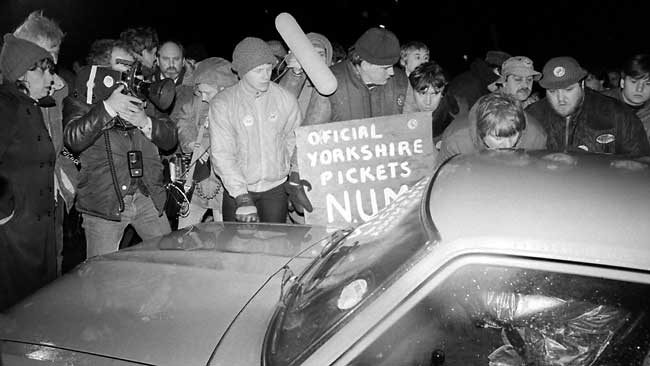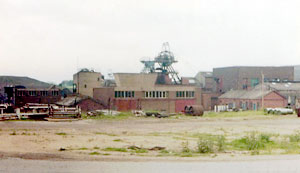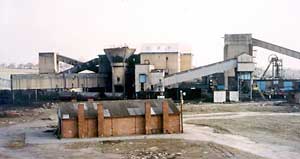

NUM picket at Bilsthorpe Colliery on the first night of the strike.
The 1984-85 Miners’ Strike was one of the most divisive conflicts of the 20th century; it divided families, communities and the UK and is still a very uncomfortable subject for many to discuss.
The lead up to the 1984-85 Miners’ Strike goes back to the 1980s and as the Nottinghamshire coalfield entered this period, 27 collieries were producing coal and were supported by a number of service units, e.g. workshops, industrial plants and a transport depot. The Nottinghamshire coalfield was spilt into two sectors for administration purposes, the National Coal Board (NCB) North Nottinghamshire Area, whose headquarters were based at Edwinstowe and NCB South Nottinghamshire Area, whose headquarters were based at Bestwood. Nationally, the North Nottinghamshire Area was very much the ‘Jewel in the Crown’ in production terms, for the NCB. Its annual production of 12 million tons from its 15 collieries made it the largest profit making coalfield for the NCB in Britain. The same could not be said for the South Nottinghamshire Area where the collieries were older and production and manpower had been declining since the mid 1960’s. In the early 1980’s annual production in the South Nottinghamshire Area totalled 8.5 million tons from its 12 collieries. The majority of the Nottinghamshire coalfield’s miners were in the Nottingham Area of the National Union of Mineworkers (NUM).

Teversal Colliery in 1980.
Colliery closures began to take place in the Nottinghamshire coalfield at Teversal (known locally as Butcherwood) in 1980 and at New Hucknall, near Huthwaite, in 1982. Despite opposition against the closures from the respective NUM Branches, both closures went ahead. Both collieries suffered from geological interaction from old workings in the region that bordered the county of Derbyshire. Shortly after these two closures the future of two more Nottinghamshire collieries, at Moorgreen and the Pye Hill Complex, came under scrutiny. Like Teversal and New Hucknall, both were situated in the older part of the Nottinghamshire coalfield near to the Derbyshire border. Both closures were eventually agreed to at local level with a staged run-down to closure taking place from 1983-1985. Moorgreen was the last operating colliery in the Eastwood area, whose coalmining background was immortalised in the novels, short stories and plays of the author DH Lawrence (1885- 1930). It became Minton Colliery in the mining-based novel , ‘Sons and Lovers’ (1913).
Despite some claims to the contrary, the Nottinghamshire coalfield was not immune from the effects of pit closures and the reduction of manpower in the early 1980’s. In addition to the closures at Teversal and New Hucknall Collieries, plus the planned rundown to closure of Moorgreen and the Pye Hill Complex, surface jobs were lost at Annesley, Newstead and Babbington collieries due to underground mergers. An agreement was reached to reduce the workforce by 550 at the threatened Annesley-Bentinck-Newstead Complex in February 1984.
Thus the scene was set for the 1984-85 Miners Strike. Three NUM national ballots in January 1982, October 1982 and March 1983 respectively had turned down industrial strike action. The 1983 ballot called for strike action to prevent colliery closures and manpower reductions after the closure of Lewis Merthyr Colliery in South Wales. The October 1982 and March 1983 NUM national ballots both turned down industrial action by nearly half; 61% against to 39% for. An influential factor in all three ballots was thought to be the introduction of enhanced redundancy terms in the coal industry in the early 1980’s, particularly for miners over 50. In the 1983 March National ballot only three NUM areas out of twenty voted for industrial strike action over pit closures; these being the traditional left-wing areas of Kent, South Wales and the Yorkshire area who voted 54% in favour of strike action. Support for strike action in the Nottinghamshire area was weak.
The 1984-85 miners’ strike started in early March 1984 and prior to this an overtime ban for NUM members had been in place since 31st October 1983. The overtime ban was put in place against a 5.2% wage offer, deemed to be inadequate, and to the threat posed by colliery closures and manpower reductions in the deep coal mining industry. On 8th March 1984 the NUM National Executive Committee (NEC) considered NCB figures, released two days previous, for a 4 million drop in production for the financial year 1984-85, with the expected loss of 20,000 jobs. This was seen by the NUM leadership to be the ‘thin end of the wedge’ with claims that the real threat to the coal-industry was over 70 colliery closures.
At the time just over 170 collieries were in operation in Britain, over 20 collieries had closed through local agreements in the year prior to the strike (1983-1984). The NUM NEC authorised strike action in Yorkshire and Scotland (and in any other NUM area) as official under the previously unused NUM National Rule 41, which dealt with strikes in areas. Previously NUM policy was to conduct a national ballot vote of NUM members under NUM Rule 43 following the implementation of an overtime ban. The Rule 41 strategy became known as ‘The Domino Theory’. The Rule 41 strategy was previously untried and relied on the effective use of flying pickets and miners in all areas respecting the sanctity of the picket line. Collective identity was a diverse and complex issue as David Howell’s 1989 study of the Lancashire Miners and Keith Gildart’s study of the North Wales miners showed.
The NUM members in the Nottinghamshire coalfield were split from the start of the 1984-85 strike and things degenerated through a series of events which AR Griffin likened the outcome to ‘the inevitability of a Greek Tragedy’.
Prior to the Nottingham Area NUM ballot scheduled for 15th-16th March, flying pickets, mainly from the Yorkshire Area of the NUM, descended into the Nottinghamshire Coalfield, with the aim to ‘persuade’ the Nottinghamshire miners into joining the strike. The majority of Nottinghamshire miners saw this action of the flying pickets as unconstitutional, and they reacted in a similar fashion as they had with the unofficial NUM strikes of 1969 and 1970, referring to the industrial action as being both unofficial and unconstitutional. It was described as not being picketing in its true sense but ‘mass blockading’ which could damaged the union. The Nottinghamshire miners voted 20,188 (73.5%) to 7,285 (26.5%) not to strike in the NUM Area ballot of 15th/16th March 1984.
With the NUM hopelessly split, and no national ballot vote forthcoming, production continued in the strategically important Nottinghamshire coalfield, even though the working Nottinghamshire NUM members adhered to the overtime ban through the duration of the strike. In the Nottinghamshire coalfield there was a strong tradition of moderate mining trade unionism, some suggest this stems from the effects of Spencerism in the 1920’s. Spencerism referred to the Spencer Union (1926-37) or Nottingham Miners Industrial Union (NMIU), which came into being following a split in the Miners Federation of Great Britain (MFGB) towards the latter part of the 1926 Miners’ lockout. Some of the more moderate area mining unions like Nottinghamshire, were the ones that became the more ‘constituently minded’ unions; industrial action and strikes were okay so long as they were conducted through the tried and trusted union procedures. A problem for the NUM was it was never truly a national union but a federal based union with an uneasy power struggle between areas and national level and vice- versa.
The strike ended after 51 weeks in early March 1985 when a NUM Special Conference voted by 98-91 for a return to work with no agreement being reached on the issue of pit closures and manpower reductions. With enhanced redundancy and severance pay in place, miners in the main NUM irrevocably divided and customer confidence irretrievably damage, the scene was set for the ‘rape of the coal mining industry’. Despite the strike ending, the NUM was about to have its greatest crisis since its formation in 1944, ironically at a conference held in Nottingham. Following the end of the 1984-85 strike it was proposed to amend the entire rules and constitution of the union, in effect the federal structure was to be abolished. Following a ballot vote of its members on the introduction of the new NUM rules in May 1985, the Nottingham Area left the NUM following the 1985 NUM Annual Conference in July 1985. An amalgamation ballot followed in the early autumn of 1985 which saw the formation of the Union of Democratic Mineworkers (UDM). The UDM’s three component area unions were the former Nottingham Area (NUM), South Derbyshire Area (NUM) and the Colliery Trades and Allied Workers Union (CTAWA), mainly a craftsmen-based union of members expelled from the NUM during the 1984-85 strike in the North-East coalfield. The UDM received authentication on 6th December 1985 and for the first time since the Spencer Union (1926-1937) the majority of Nottinghamshire miners were represented by two mining trade unions.

Pye Hill No.2 Colliery in its last week of production in 1985.
Before 1984 there were 25 pits in the Nottinghamshire area. After the strike two pits closed as part of the planned closure: Moorgreen and Pye Hill. In 2010 Welbeck colliery closed and in July 2015 Thoresby colliery is due to close bringing to an end coal mining in Nottinghamshire.